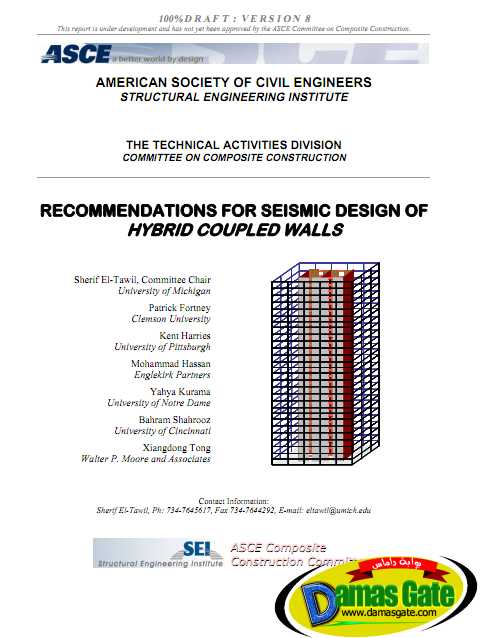Recommendations for Seismic Design of Hybrid Coupled Walls
Reinforced concrete (RC) coupled wall systems, where RC beams couple two or more RC walls in series are frequently used in medium and high-rise construction. The benefits of coupling in such systems are well recognized and understood. The coupling beams provide transfer of vertical forces between adjacent walls, which creates a frame-like coupling action that resists a portion of the total overturning moment induced by the seismic action. This coupling action has three major beneficial effects. First, it reduces the moments that must be resisted by the individual wall piers resulting in a more efficient structural system. Secondly, it provides a means by which seismic energy is dissipated over the entire height of the wall system as the coupling beams undergo inelastic deformations. A final important advantage of a coupled wall system is that it has a lateral stiffness that is significantly greater than the sum of its component wall piers permitting a reduced footprint for the lateral load resisting system.

Introduction
The structural response of coupled walls is, however, complicated by the fact that the system is comprised of components that exhibit significantly different ductility demands. Figure 1 shows the idealized lateral force-deformation response of a coupled wall structure as the sum of the individual cantilever pier flexural responses and the frame-like response of the coupling action provided by the beams. In contrast to the walls, the coupling beams must undergo significant inelastic deformations in order to allow the structure to achieve its lateral yield strength, R
. As the system continues to deform laterally in a ductile manner, the wall ductility ratio, defined as the ratio of the ultimate deformation to that at yield, is significantly smaller than that of the beams. If the beams are unable to cope with the high ductility demands imposed upon them, the coupling action deteriorates leading to a drop in the lateral resistance and a dramatic change in the dynamic properties as the system eventually degenerates into two (or multiple) independent, uncoupled wall piers.
The shear force and deformation demands expected on coupling beams during a design-level seismic event, coupled with their low span-to-depth ratio and the degradation of shear resisting mechanisms attributed to concrete under load reversals, have led designers to provide special diagonal reinforcement detailing for and in the vicinity of RC coupling beams (ACI 2005). This special reinforcement complicates erection, potentially increasing both construction time and cost. Furthermore, the limited shear capacity of RC coupling beams often requires designers to provide impractically deep members (Harries et al. 2005). To mitigate these problems, some engineers have turned to structural steel coupling beams as an alternative to reinforced concrete beams. The resulting structural system is referred to as a hybrid coupled wall (HCW) system and is the subject of this report.
Download
*